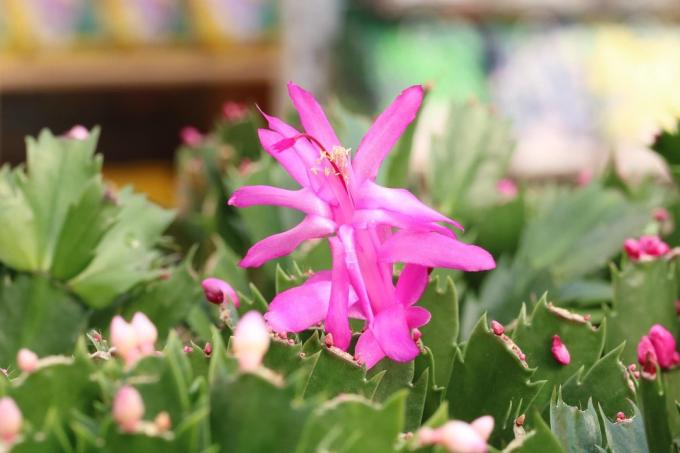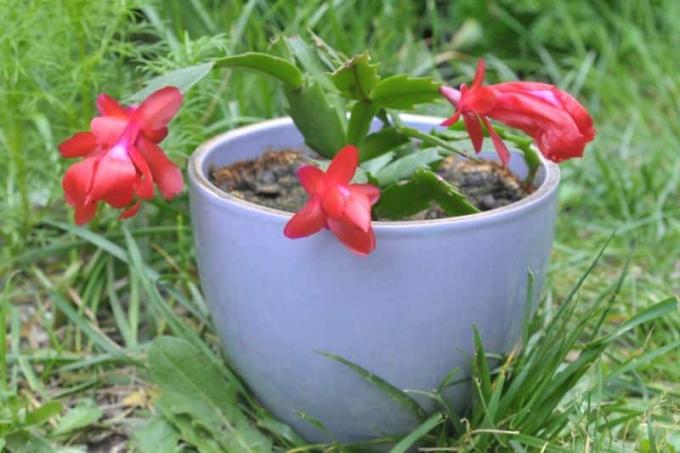
The Christmas cactus is one of the most popular indoor plants. With good care, it produces impressive flowers. A prerequisite for this flowering splendor on the Christmas cactus is regular repotting. We show step by step how to do it.
In a nutshell
- flowering several times a year under good conditions
- fast growing cactus
- annual repotting recommended
- Vessel with drainage hole important
- use lean cactus soil
Table of contents
- Repot Christmas cactus
- time
- substrate
- Instructions for repotting
- The cactus pot
- Repot a freshly bought Christmas cactus
- frequently asked Questions
Repot Christmas cactus
Christmas cacti belong to the genus Schlumbergera in the cactus family. They grow very quickly in good conditions. experts recommend the decorative cacti to be supplied with fresh substrate every year. The pot is too small at the latest when roots grow through the drainage hole. Then it's time to repot the Christmas cactus.
time
The best time is right after the end of the flowering period. Under no circumstances should you repot the Christmas cactus before or during flowering. The plant can hardly cope with the stress in the flowering phase. She would probably shed the buds.

A notice: Christmas cacti bloom from November through January.
substrate
As a cactus plant, Schlumbergera prefers lean soil. We recommend using commercially available cactus soil. The plant will thank you if you also mix in some gravel.
Instructions for repotting
- Remove the Christmas cactus from the pot.
- Remove the old substrate from the roots. If this is difficult, rinse the roots under running water.
- Place a layer of gravel or pottery shards in a new jar. Fill in fresh cactus soil.
- Put the plant in the jar.
- Fill the pot up with soil. Press the earth lightly.
- Water the Christmas cactus thoroughly so that it can grow well.

A notice: Schlumbergera is a cactus, but it doesn't have spines. The thick-fleshed leaves only have soft bristles that cannot be used to injure oneself.
The cactus pot
A suitable container for the Christmas cactus should
- be big enough for the roots to have enough space in it
- have a drainage hole
- have a diameter of about one third of the growth height

Tip: Whether you choose a pot made of clay or plastic is up to you. However, do not use very dark pots that would heat up significantly in the sun.
Repot a freshly bought Christmas cactus
Sometimes freshly bought Schlumbergera do not develop as desired. Its leaves hang down and no flowers emerge from the buds. The reason for this is usually the substrate that is too moist. In this case, we recommend repotting the newly acquired plant and providing it with fresh substrate. After repotting, the Christmas cactus must be watered. After that, it only needs new water again when the upper layer of soil is dry.

A notice: If the Christmas cactus is already showing signs of flowering, you must not repot it. In this case, do without watering and fertilizing for the time being. In most cases, the plant will then recover.
frequently asked Questions
Christmas cacti do best in a sunny to partially shaded location. Protect the plant from direct sunlight. In summer you can put the plant on the terrace.
Supply the decorative plant with cactus fertilizer every three weeks during the growth phase. Cacti that receive new soil every year have a good nutrient base. Do not fertilize them at all to avoid over-fertilization.
Yes, Schlumbergera also benefits from a dormant period after flowering. During this time you should place the plant in a cool winter quarters, do not fertilize and only water minimally.

